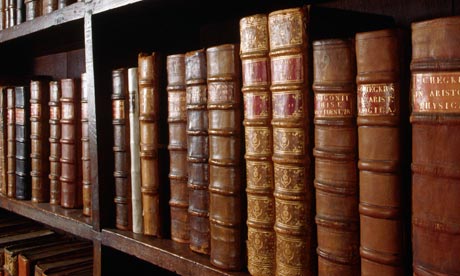Naming the 18th Century
Special Session
What's at stake in naming this period "long" (1660-1830), "short" (1715-1789), early modern, Enlightenment (etc.)? What's its role in the new MLA? 300-word abstracts by 15 March 2015; Dustin D. Stewart (dustin.d.stewart@gmail.com) and Joshua Swidzinski (js3683@columbia.edu).
 |
| Literary studies logic: Start with the old stuff. |
The idea of the period-specific scholar is both a new invention and an old one, and one could probably make a convincing argument for the continued importance of focusing on individual time periods versus becoming a “Generalist”—a designation that is increasingly popular on job postings yet remains suspiciously bland and non-rigorous in the minds of many scholars.
 |
| Anthologies suggest distinct time periods...but is that such a good idea? |
We could consider it via genre, theme, style, topic, or in even more arbitrary ways, such as alphabetically by the title of the work or author’s last name. Even with such an arbitrary organizational method, we could probably find a way of making sense of these juxtapositions. Consider a course on “B” literature, and the fascinating juxtapositions of Borges, Bulgakhov, Bronte and Balzac.
Of course, one of the most pressing reasons for reading works chronologically, aside from its seeming “logical” to go “in order,” is because in literary studies, authorial output is often influenced by what the author read him/herself—and those are, of necessity, works written earlier or concurrently with his/her own. The idea of being able to trace an author’s reading history and to find those influences in a work is a powerful and appealing one. Similarly, in our scholarship, we often imagine that by studying by time period, we may uncover changes in style, topic, and form that might otherwise escape our discerning eye. Scholarly claims often focus on making an argument for how a certain kind of reading shows us something about the time period it was written in or the ideas circulating at the time. Certainly this is evident eighteenth-century studies, where the eighteenth-century is the “first time” that we find an example of X; or Y trend in this time period indicates that such-and-such was changing in the eighteenth-century.
 |
| It's comforting to think of history as progress and improvement... but that's not always the case. |
Projects relating to the Enlightenment and Enlightenment personhood are also very of-the-moment. Various claims have been made for the eighteenth century, the long eighteenth century, the Enlightenment, the Neoclassic period, the Age of Johnson, the Age of Satire, late Early Modern period…the list could go on. We ponder why certain styles of poetry became popular while others receded; we theorize the rise of nationhood at this time; we make arguments as to the changing role of women, class divisions, sexuality, and race. But in many ways, these arguments seem constrained by our emphasis on the time period rather than liberated or enhanced by it.
 |
| Is the eighteenth century truly the Age of Satire? Why not the 19th century? Or the 20th century? |
Such claims seem, at least to me, to construct a false history of the female cross-dresser and her role in British literature. To look at female cross-dressing only in eighteenth century literature is to ignore the role of cross-dressing in medieval and early modern England as well as its continuing role in nineteenth-century culture. Similarly, to look at female cross-dressing only in an English context or even an English-speaking context is to risk making claims about this phenomenon that are incomplete. Female cross-dressers were not limited to an English context, yet most scholars would find it difficult to find a way of writing about these representations in other cultures unless they were in a Comparative Literature program.
To bring up the issue of Comparative Literature means also having to consider literary studies in different languages. Literary studies in other language—Spanish or French or German, for example—may have other kinds of chronological divisions in their time periods. Periodicity is, after all, tied to certain time periods that have a distinctive relationship to the history of the country that they represent.
I don’t mean to sound as if I’m only throwing up roadblocks here. I love what I do and what I study; I love being an eighteenth-centuryist. I enjoy going to ASECS, learning about the eighteenth century, and spreading my love of it to everyone I know. At the same time, I try not to forget the limitations of my methods and thinking. It’s important for our students to know that no time period is homogenous and that our world is never just progressing forward; sometimes we’re marching backwards. The linear progression of history and creative output is an organizing fantasy, one that may need to be rethought as the modern university changes and one that we cannot, should not ignore in our own research.
No comments:
Post a Comment